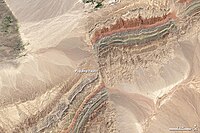
Photo from wikipedia
In recent studies on the recognition of graphitized gouges within the principal slip zone (PSZ) of the Longmenshan fault in China, we proposed that the presence of graphite might be… Click to show full abstract
In recent studies on the recognition of graphitized gouges within the principal slip zone (PSZ) of the Longmenshan fault in China, we proposed that the presence of graphite might be evidence of fault slip. Here, we characterized the clay- and carbonaceous-rich gouges of the active fault zone of the Longmenshan fault belt using samples collected from the trench at Jiulong, which was deformed during the 2008 MW-7.9 Wenchuan earthquake, to determine if graphite is present and study both the processes influencing fault behavior and the associated faulting mechanism. Mineralogical and geochemical analyses of the Jiulong trench sample show the presence of a hydrothermal mineral (i.e., dickite) integrated with dramatic relative chemical enrichment and relative depletion within a yellowish zone, suggesting the presence of vigorous high-temperature fluid–rock interactions, which are likely the fingerprint of thermal pressurization. This is further supported by the absence of carbonaceous materials (CMs) given the spectrometric data obtained. Interestingly, the Raman parameters measured near the carbonaceous-rich gouge fall within the recognized range of graphitization in the mature fault zone, implying the origin of a mature fault, as shown in the companion paper. According to both the sharp boundary within the very recent coseismic rupture zone of the 2008 MW-7.9 Wenchuan earthquake and the presence of kinetically unstable dickite, it is strongly implied that the yellow/altered gouge likely formed from a recent coseismic event as aconsequence of hydrothermal fluid penetration. We further surmise that the CM characteristics varied according to several driving reactions, e.g., transient hydrothermal heating versus long-term geological metamorphism and sedimentation.
Journal Title: Minerals
Year Published: 2018
Link to full text (if available)
Share on Social Media: Sign Up to like & get
recommendations!